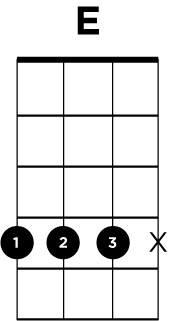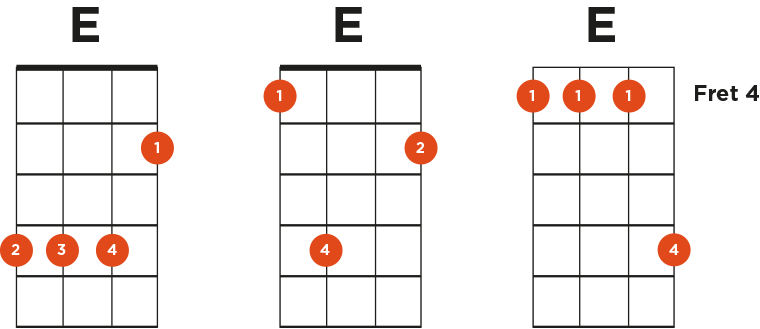The e chord is every beginner ukulele player’s nemesis. Players will go to great lengths to avoid playing an E chord on ukulele. It’s not uncommon for people to play an E7 in it’s place or just to transpose a song completely. Check out my guide to helping you get to grips with the e chord…
Can’t I just permanently avoid playing an E chord?
In a word, no. Well technically you could but you shouldn’t. Why place that restriction on yourself? That’s like saying you’re only ever going to play down strums because up strums are a little bit tricky. It’s hugely limiting to you and your ukulele playing. Get to grips with the E chord and you’ll never need to transpose songs or drop in an E7 that might not work anyway.
The good news…
Here comes the good news, just like every chord there are multiple ways to play an E (otherwise known as chord inversions) and some are easier to fret than others. It’s a case of selecting the one that fits into what you’re playing and which chord you’re transitioning from. Here’s 3 of them (there are more though)…
Looking at the chord boxes above, it’s the first E chord that usually strikes fear into a players heart. Essentially this version of an E is a D chord shifted up 2 frets. I personally almost never play this version of the e chord they way I’ve shown it in the diagram. More often than not I will play this chord with 2 fingers using my third finger to bar strings 2,3 and 4 of fret 4. It takes a little getting used to, and again I would recommend using the 60 second chord changes method daily to get this version down.
The second version of the E chord shown above is quite different and there’s no barring involved (phew). I’m more likely to call on this shape when I’m coming from a chord that shares similar fretting positions. A G chord is a good example, you get to leave your second finger where it was.
Finally, and in my opinion the easiest way to play an E – simply bar all the strings at fret 4 with your first finger and then use your pinky to hold down fret 7 of the A string (help playing barre chords here). If you’re coming from a bar chord then it makes sense to stay with another bar chord and the transition should be relatively easy. The only real issue with this version is that it can sound a little strange if you’ve been playing open chords before it (but try it and see) and it can also be a bit of a jump moving 4 frets higher.
More options to master the E chord
There are more ways to play an E on ukulele but we’ll stick with those for now. I’d highly recommend getting to grips with each one. Over time you’ll start to find that you develop a feel for which one you should be using in the context of the song that you’re playing. Take a minute every day to work on your e chords – maybe even throw it into your practice routine, you’ll have them mastered in no time!
Extra – the really easy way to play an e chord
 If you’ve read this far then congratulations, your reward for reading on is this rather easy way to play an e chord.
If you’ve read this far then congratulations, your reward for reading on is this rather easy way to play an e chord.
Notice it’s the same as the rather difficult way to play an e chord but this time we’re either muting or just not strumming the bottom (A) string. That’s because it’s not necessary.
This is where a bit of chord construction knowledge comes in handy. Fear not though, I’ll save the lesson on chord construction for another day. All you need to know is, a major chord consists of only 3 notes. So that’s all we need.
Ordinarily we fret the A string at fret 2 giving us a B but as we already have a B note fretted on the G string we don’t need to have another in. You can simply leave it out and you’ve still got an E.






Thank you so much! I’ve been trying to learn E for weeks!
Hope it helps Roan!
Thank you I will try all of them with the group
Thank you that video was very helpful.
I was wondering how to play the e major when hold 4 chords on fret 3 and holding down a on fret 6? When I do it, it doesn’t make the right sound am I holding down to hard plz make a video about e major and to get right.
I think maybe you’ve read the chord box a little wrong – if you’re referring to the barre chord version of E, you need to barre at fret 4 and drop your pinkie finger on fret 7.
Hope that helps
God, you are brilliant. When I saw this chord in my beginner’s book I thought I’d give up! But now I have several ways of doing this little b*gger in my arsenal. Maybe, just maybe, my uke won’t be “just for Christmas” xxx
I have avoided the E chord for several years as I couldn’t find one to manage. Thank you soooo much.
Could u help me with a F#7 chord please??
Regards
Elaine
F# A# C# E. The E string has to play the F#, so the E is on the C string and the C# is on the A string. The A# is on the G string.
So that’s 3424, like an E7 (1202), but 2 frets higher. It’s an awkward chord, there’s no denying that. If you’re comfortable retuning your ukulele, tune the G string to F# and play 0101. But if not, 3424’s the way to go.
E chord has been tough, but slowly, over the past month, it’s coming together. My fingers not nearly flexible enough to play it the way you are supposed to, or the way Dave does by placing my index finger on A string second fret and barreing GCE strings on the fourth fret, but I can barre GC on the fourth fret and use my ring finger on E…it’s a work around that works! I just have to be diligent and keep practicing!